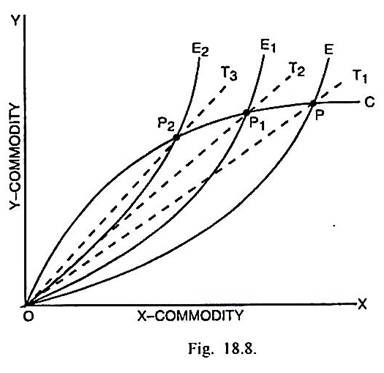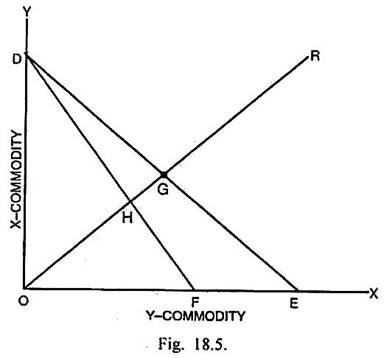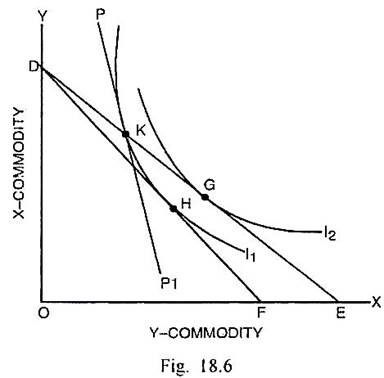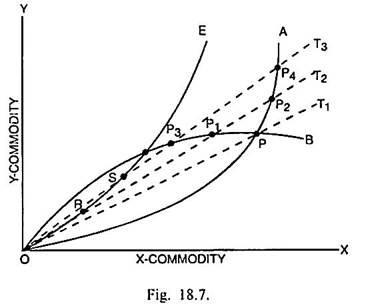Jacob Viner’s partial equilibrium analysis, based upon trade creation and trade diversion effects, is undoubtedly useful but is only of elementary character. The writers like R.G. Lipsey and J. Vanek have analysed the theory of customs union in the general equilibrium framework.
1. The Lipsey Model of Customs Union:
In the partial equilibrium approach, Jacob Viner pointed out that trade diversion causes a loss in welfare. This assertion of Viner came to be criticised at the hands of J.E. Meade, F. Gehrels and R.G Lipsey. In their opinion, Vinerian conclusion can be valid only if it is assumed that the commodities are consumed in a fixed proportion and substitution effect is not present.
Assumptions:
Lipsey began by demonstrating that Viner’s assertion can be valid under the following assumptions:
ADVERTISEMENTS:
(i) There are three countries—A, B and C. Country A is the home country, country B is the member or partner country and country C is a nonunion member country.
(ii) The home country A is a small country having the highest costs.
(iii) The non-union country C is the most efficient and has the lowest costs.
(iv) There are two commodities, X and Y.
ADVERTISEMENTS:
(v) Country A and B specialise completely in the production of X-commodity.
(vi) Commodity Y is imported from some foreign country.
(vii) The two commodities are consumed in some fixed proportion irrespective of structure of relative prices.
(viii) The supply of the commodities is perfectly elastic.
ADVERTISEMENTS:
(ix) The production takes place under the conditions of constant returns to scale.
On the basis of these assumptions, Lipsey put Jacob Viner’s model into a general equilibrium framework and proceeded to demonstrate that trade diversion can lead to a loss in welfare after the formation of customs union. This has been explained through Fig. 18.5.
In Fig. 18.5, commodity X is measured along the vertical scale and commodity Y is measured along the horizontal scale. The home country A specialises completely in the production of X commodity and production of X takes places at D. Country A imports OE quantity of Y from C in exchange of OD quantity of X.
The line DE represents the best possible terms of trade available to country A before the formation of customs union. Consumption takes place at G in a fixed proportion measured by the slope of line OR.
When customs union is formed with country B, the trade gets diverted from C to B, the member country which is less efficient than country C. Now country A exports OD quantity of X commodity in exchange of OF quantity of Y commodity from partner country B. The terms of trade in this case are indicated by the slope of the line DF. It clearly, shows that the terms of trade have got worsened for the home country A after the formation of customs union.
Consumption still takes place in the fixed proportion on the line OR at point H. It means no substitution takes place despite relative changes in prices of two commodities. The point H is clearly inferior to the point G because it represents smaller amounts of both the commodities consumed. Thus Viner’s assertion becomes valid that trade diversion results in a loss in welfare.
Lipsey, however, pointed out that J. Viner’s assumption concerning consumption in fixed proportion is unrealistic. If this assumption is dropped, the trade diversion due to the formation of customs union can have two welfare effects opposite to each other. First, after the formation of customs union, country A will have to pay a higher price for commodity Y than before because the partner country B, from which import is being made, is less efficient than the non-member country C.
Second, since no import duty is being paid on imports from country B, the domestic price of Y will fall bringing about increased consumption of Y due to its substitution for X. This may result in an increase in the welfare in country A. Given these two off-setting effects whether customs union and consequent trade diversion will increase welfare or not, can be explained through Fig. 18.6.
In Fig. 18.6, it is supposed that the home country A specialises completely in the production of X commodity and it originally imports OE quantity of Y from the most efficient country C in exchange of the export of OD quantity of X. The line DE represents the terms of trade for country A. These are the best possible terms of trade because country C is the cheapest source of supply of the commodity Y. G is the point of consumption where the line DE is tangent to the community indifference curve.
Before the formation of customs union, as tariff is imposed by country A on Y commodity, the terms of trade line is now PP1. It is tangent to the community indifference curve I1 at K. Since K lies on lower community indifference curve, there is loss in welfare after the imposition of tariff. The TOT at K are exactly the same as at G because both G and K lie upon the same line DE.
If a customs union is formed by A and B, there will be trade diversion. Country A will import Y commodity from the partner country B rather than the non-member country C. As OD quantity of X is exchanged with OF quantity of Y, the terms of trade are measured by the slope of the line DF. Since DF is tangent to the community indifference curve I1 at H, this is the point of consumption after the customs union is formed. At H. the people in country A consume less quantity of X and more quantity of Y.
It means there is substitution of Y in place of X. The level of satisfaction, however, remains the same because points K and H lie upon the same community indifference curve I1. Thus Lipsey arrived at the conclusion that there is no reduction in welfare due to the formation of customs union and consequent trade diversion. Such a conclusion is quite contrary to what Jacob Viner had stated.
ADVERTISEMENTS:
Criticism:
Lipsey’s general equilibrium model of customs union has been attacked by economists on the following grounds:
(i) Lipsey’s refutation of the conclusion given by Jacob Viner rests upon the assumption that Viner’s supposition of fixed proportion in consumption was invalid. According to Jagdish Bhagwati the reduction in welfare is not necessarily because of the fixed proportions in consumption but it is because of Vinerian implicit assumption of a constant level of imports.
When it is assumed that the volume of imports before and after the formation of customs union is unchanged, it must lead to the conclusion that trade diversion results in loss in welfare. But if the formation of customs union causes an increased volume of imports, there is likelihood that the net welfare remains constant or it rises compared to the pre-union situation.
ADVERTISEMENTS:
(ii) Whether trade diversion causes a loss or gain in welfare or leaves it unaffected is conditioned by what happens to the terms of trade. If the deterioration in country A’s terms of trade is such that there is a shift from DE to DF (as shown in Fig. 18.6), the consumption equilibrium remains on the same community indifference curve I1, and the level of welfare after the formation of customs union remains constant.
In case deterioration in A’s terms of trade is of a larger magnitude than indicated by the shift of line DE to DF, the post-union consumption equilibrium will be determined at a community indifference curve that lies to the left of I1. Consequently, the customs union will cause a reduction in welfare. If the deterioration in the terms of trade causes the TOT line to lie between DE and DF, the consumption equilibrium will get determined at a community indifference curve higher than I1. It will signify a gain in welfare after the formation of customs union despite trade diversion.
2. The Vanek Model of Customs Union:
Jaroslav Vanek has employed the technique of offer curves to analyse the general equilibrium theory of the customs union.
Assumptions:
Vanek’s model of customs union rests upon the following main assumptions:
(i) There are three countries—A, B and C. Country A is the home country. Country B is the partner country in the customs union and country C is the non-member country. It represents rest-of-the world.
ADVERTISEMENTS:
(ii) Each of these countries consumes, produces and exchanges two commodities X and Y.
(iii) Commodity X is the exportable commodity of country A.
(iv) Commodity Y is the exportable commodity of the partner country B.
(v) Commodity Y is also the exportable commodity of the non-member country C.
(vi) Neither of the two commodities is inferior at any relative price or the level of income.
(vii) Before the formation of customs union, the home country A was trading with the non-member country C.
ADVERTISEMENTS:
The pre-customs union trade situation can be explained through the respective offer curves of the two countries. Vanek has made use of the excess offer curve to analyse the trade between the union and the rest of the world (country C). The excess offer curve can indicate various quantities of X-commodity which country A is willing to exchange with the different quantities of Y offered by the non-member country C. The trade situation between the union and the non-member country is explained through Fig. 18.7.
In Fig. 18.7., OA and OB are the offer curves of Y countries A and B respectively before the formation of the customs union. If OT1, is the TOT line, the trade between A and B is fully balanced at the point P and the union countries can offer no quantity of X commodity to the non-member country C. In other words, they do not wish to trade with C because their excess offer is zero.
If the TOT line is OT2, the country A wishes to trade at P2 on its offer curve and country B wishes to trade at P1 on its own offer curve. Now country A offers more quantity of X than the country B is willing to import. Similarly A requires more quantity of Y than country B is willing to offer. The distance P1P2 measures the excess offer of X commodity for Y by country A. By taking a distance equal to P1P2 from origin along the line OT2, the point R can be specified (OR = P1P2).
Suppose now the TOT line is OT3. Country A wishes to trade at P4 and country B wishes to trade at P3. Country A offers more quantity of X than what country B can absorb. Similarly country A demands more quantity of Y that country B can offer. The distance P3P4, in this case, measures the excess offer of X by country A that can be exported to the non-member country C.
Now taking a distance OS equal to P3P4 along OT3 from the point of origin, another point S can be obtained (OS = P3P4). By joining points R and S with the origin, it is possible to derive union’s excess offer curve OE.
ADVERTISEMENTS:
Given the excess offer curve of the union and the offer curve of the non-member country, the optimum welfare position from the view point of customs union can be determined. In Fig. 18.8, OE is the excess offer curve of the customs union and OC is the offer curve of country C (rest-of-the- world).

If the union goes on raising the common tariff against the rest-of-the world, the excess offer curve of the customs union shifts further to the left to OE2. In this case the intersection between OE2 and OC determines trade equilibrium position to P2. The TOT line OT3 becomes still steeper indicating further improvement in the terms of trade for the customs union and worsening of the terms of trade for the rest-of-the world.
The increase in external tariff not only improves the terms of trade but also raises the level of welfare. The point of welfare maximisation is reached where the trade indifference curve of the union becomes tangent to the offer curve of the rest-of-the-world (country C). If this tangency occurs at the point P2, it indicates the optimum tariff that corresponds with the maximum welfare for the member countries of the customs union.
Thus Vanek’s model establishes a relationship between the level of external tariff and the welfare maximisation of the member countries. This approach makes a significant departure from Viner and Lipsey’s approaches. It analyses the welfare effect of customs union without making reference to trade-creation and trade-diversion effects.


